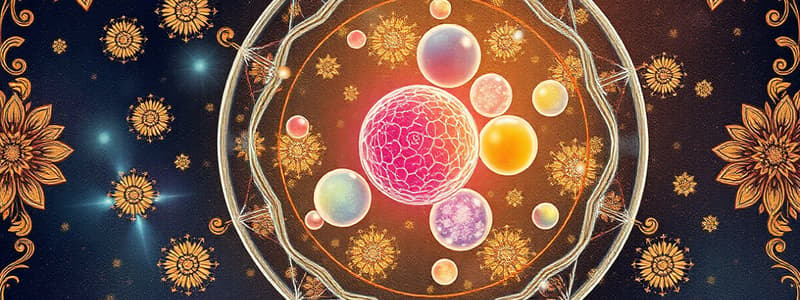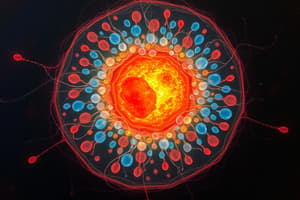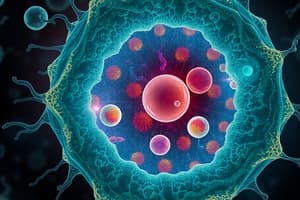Podcast
Questions and Answers
Which structure is responsible for the formation of ribosomes within the nucleus?
Which structure is responsible for the formation of ribosomes within the nucleus?
- Chromatin Network
- Nucleoplasm
- Nucleolus (correct)
- Nuclear Membrane
The nucleus can be absent in all types of cells.
The nucleus can be absent in all types of cells.
False (B)
What is the function of the nuclear membrane?
What is the function of the nuclear membrane?
It regulates the exchange of materials between the nucleus and the cytoplasm.
The number of chromosomes in humans is ______.
The number of chromosomes in humans is ______.
Match the following organisms with their number of chromosomes:
Match the following organisms with their number of chromosomes:
What does the chromatin network form during cell division?
What does the chromatin network form during cell division?
Most cells are mono-nuclear.
Most cells are mono-nuclear.
Name the liquid that fills the nucleus.
Name the liquid that fills the nucleus.
What is the primary function of the nuclear membrane?
What is the primary function of the nuclear membrane?
All cells contain a nucleus.
All cells contain a nucleus.
What is the role of the nucleolus in the nucleus?
What is the role of the nucleolus in the nucleus?
The _______ is the gelatinous substance found within the nucleus.
The _______ is the gelatinous substance found within the nucleus.
Match the following organisms with their number of chromosomes:
Match the following organisms with their number of chromosomes:
Which type of cell can contain more than one nucleus?
Which type of cell can contain more than one nucleus?
Chromosomes can be seen at any stage of the cell cycle.
Chromosomes can be seen at any stage of the cell cycle.
What describes the chromatin network?
What describes the chromatin network?
Flashcards are hidden until you start studying
Study Notes
Nucleus
- The nucleus is the essential control center of the cell, responsible for cell survival and functions through communication with the cytoplasm.
- Cells without a nucleus degenerate rapidly, like adult red blood cells.
- Nucleus shape varies based on cell type, ranging from spherical and oval to lobed and irregular.
- The nucleus is typically the largest organelle, but size and location vary depending on cell type.
- Most cells are mono-nuclear, while some can be di-nuclear (e.g., cartilage, liver, and muscle cells).
- The nucleus is centrally located in stem cells and peripheral in some secretory cells (e.g., fatty and mucous cells).
Nuclear Membrane (Envelope)
- A thin, double-layered membrane surrounding the nucleus.
- It has unique physical and chemical properties to regulate exchange of materials between the nucleus and cytoplasm.
- The membrane contains micro pores for selective passage of particles.
- It is absent in prokaryotic organisms like bacteria and blue-green algae.
Nucleoplasm
- A colorless, gelatinous fluid filling the nucleus, holding the nucleolus and chromatin network.
Nucleolus
- One or more nucleoli present in the nucleus (e.g., onion cell nucleus has four).
- A spherical structure within the nucleus, composed of protein and RNA.
- Plays a crucial role in ribosome formation, essential for protein synthesis.
Chromatin Network
- An interconnected, irregular filamentous structure.
- During cell division, the chromatin network condenses into chromosomes, rod-like structures carrying genes.
- Chromosomes transmit genetic information across generations, playing a critical role in reproduction, development, and mutations.
- Visible only during cell division, with a variable number of chromosomes in different organisms.
Chromosome Number
- Organisms have fixed chromosome number in their somatic cells.
- Ascaris lumbricoides has only 2 chromosomes, the fewest among organisms.
- Spanish butterflies have 380 chromosomes, demonstrating wide variation.
- Humans have 46 chromosomes.
The Nucleus: The Cell's Control Center
- The nucleus is the vital component of all living cells, crucial for maintaining cellular survival.
- The nucleus controls the cell's activities by directing protein synthesis and storing the cell's genetic information.
- The nucleus is essential for cell survival, as cells without a nucleus degenerate quickly.
- The nucleus exhibits diverse shapes depending on the cell's type.
- The nucleus is the largest organelle within the cell, its size varies depending on the cell type.
- Most cells have a single nucleus (mononuclear), but some, like cartilage, liver, and muscle cells, can be di-nuclear.
- The nucleus is centrally located in stem cells and peripherally located in some secretory cells like fat and mucous cells.
Nucleus Components
- The nucleus is enclosed by a nuclear membrane or envelope, a double-layered structure with its own unique characteristics.
- The nuclear membrane acts as a barrier and regulates the exchange of materials between the nucleus and cytoplasm through tiny pores.
- This membrane is selectively permeable, allowing only specific substances to pass through.
- All cells, except for prokaryotes (bacteria and blue-green algae), have a nuclear membrane.
- Nucleoplasm, a colorless, gelatinous liquid, fills the nucleus and contains the nucleus's other components.
- Nucleoli, small, spherical structures inside the nucleus, are responsible for ribosome formation, which is essential for protein synthesis.
- Chromatin network is a dynamic filamentous structure that forms chromosomes during cell division.
- Chromosomes carry genetic information (genes), responsible for transferring traits from one generation to another.
- Chromosomes are only visible during cell division, and the number of chromosomes varies across different organisms.
Chromosome Numbers
- Ascaris lumbricoides, a type of roundworm, has the fewest chromosomes among organisms, only 2 in somatic cells.
- The Spanish butterfly possesses 380 chromosomes, the housefly has 12, the frog has 26, the pigeon has 80, and the horse has 64 chromosomes.
- Humans have 46 chromosomes in their somatic cells.
Studying That Suits You
Use AI to generate personalized quizzes and flashcards to suit your learning preferences.




